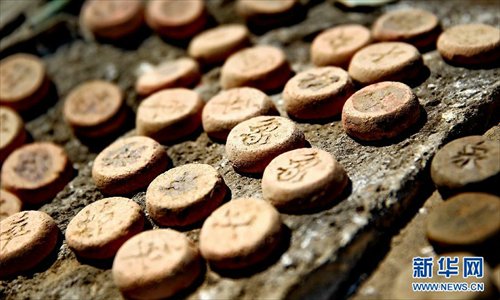Fake news about India listing Chinese chess as a cultural heritage amuses netizens
By By Du Qiongfang and Chen Xi Source:Globaltimes.cn Published: 2020/4/15 0:26:49

Pictured are Chinese chess pieces discovered by workers during a renovation of the Great Wall in Qinhuangdao, Hebei Province. File Photo: Xinhua
It may sound a bit ridiculous to most Chinese chess players, but fake news has gone viral on multiple Chinese news portals about India applying for the sixth time to list Chinese chess as their cultural heritage with the United Nations Educational, Scientific and Cultural Organization (UNESCO) and it was trending on Sina Weibo Tuesday.
On Tuesday night, the news was proved to be fake after a researcher with the Chinese Academy of Social Sciences pointed out that there is no record of such an application by India on UNESCO's official website, The Paper reported Tuesday.
The fake news story said one of the reasons that India gave when applying was that there is a piece, xiang (elephant) in Chinese chess, and as elephants originated in India, logically Chinese chess was derived from India's chaturanga, a strategy game similar to chess that is almost extinct. Furthermore, Chinese chess was an exotic product brought to China on the Silk Road from the Persian Empire, which is how India's chaturanga was imported.
However, Chinese chess grandmaster Wang Bin remarked that the most direct and apparent evidence of the origin of Chinese chess are Chinese characters on the chess pieces.
Wang told the Global Times on Tuesday that according to the pieces on the board of India's chaturanga, the Indian game was much closer to international chess and quite different from Chinese chess. Like international chess, Indian chaturanga has no cannon, while Chinese chess does.
Wang noted that the rules of different forms of chess indicate a society's culture and tactics of war. "For example, the commander [king] can only move in the square circle of nine cells, because Chinese emperors usually commanded from the rear rather than moving around," Wang said.
From a historic perspective, India's chaturanga was imported to the Persian Empire between the 5th century AD and 7th century AD. However, records of Chinese chess date back to the much earlier Warring States Period (475BC-221BC), noted Wang.
Shah Nishith Avinash, an Indian living in Mumbai, told the Global Times on Tuesday that India has a long history of playing chess and there is a village called Marottichal where many villagers are addicted to playing chess.
"We Indians all know the interesting story that the game saved villagers from bad habits of drinking and gambling," he said.
The hashtag that India has applied to list Chinese chess as a cultural heritage for the sixth time had earned 390 million views on China's Twitter-like Sina Weibo as of Tuesday night, with many Chinese netizens posting that they are amused by the joke.
"Although it is a joke, the whole incident and the previous controversy when South Korea applied Gangneung Danoje Festival, which is similar to China's Dragon Boat Festival, as a heritage made me realize that we need to be alert and speed up the application process in Chinese cultural heritage. Many things have been passed down for thousands of years, and we need to let the world know those are China's cultural heritage," another netizen posted on Weibo.
Posted in: SOCIETY